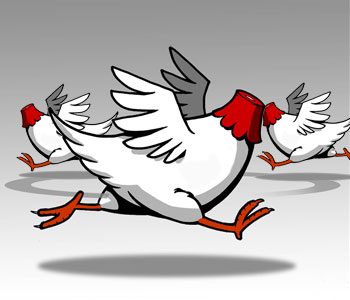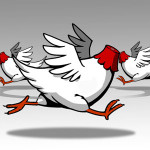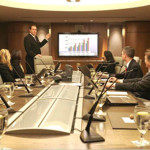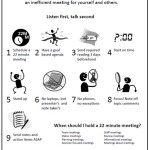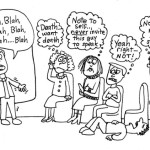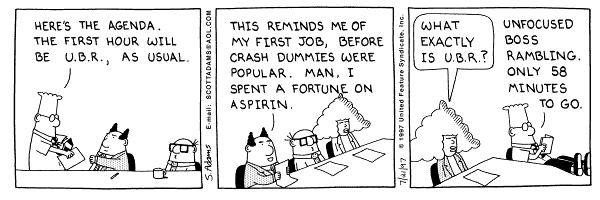We’ve all been in business meetings of one sort of another. While you can’t run a business of any sort without some sort of meetings, there are many occasions, notably in corporate bodies of private or public persuasion. There is of course much academic research about the roles people adopt or are given in meetings; to illustrate this principle I’ve provided a full and detailed analysis of the formal guises below, though it does not necessarily accord with the practice.
Good meetings may take many forms: they may include some humour (though rarely the beaming smiles from the beautiful, as suggested in the photo below), some rabble-rousing, maybe filled with anecdotes. Lots can be short and to the point (especially those conducted standing up rather than sitting down), while others are much longer and with a full agenda to work through, punctuated by coffee breaks and lunches (not necessarily bad, providing they stick to the point and get things done.)
But many are awful, unfocused and counterproductive – and how many of us have been present at meetings that are truly excruciating? At best they may be boring – death by Powerpoint being one prime example – but there are many more ways to make meetings counterproductive, and new ones are occurring by the day. This is a pretty good analysis of the time-wasting, though even quite well-run meetings can be ruined by being conducted in hot airless rooms where everyone drops, physically or mentally, off to sleep. At the other extreme, there are the private conversations and general bitchiness that makes for a wonderfully edgy atmosphere throughout as the tension builds.
The primary obstacle to progress, for progress of some description is surely the purpose of any meeting, are the private agendas of any individual there. Remember that there will typically be a fair sprinkling of professional meeting attenders who see their role being to come up smelling of roses but to take no actions whatever in the minutes, thereby subverting the strict protocol of the agenda. Actions resulting from the discussion are the lifeblood of any meeting, and if they are not assigned by the chair and accepted by recipients, sometimes in absentia, the meeting will grind to a halt. Non-acceptance is substituted by further debate or ways to fudge or complicate the issue, thus a game forms in which the hot potato is thrown around the room. Whoever can’t find ways of palming off the spud will end up having something to do, and by implication taking the blame when it goes tits-up.
The chair may choose to accept this and run proceedings democratically, but may alternatively try to rule with the proverbial rod of iron – and in the case of a bad chair this may be accepted with a fear of the consequences, ignored totally or treated with disdain. These days more chairs will be met with silent derision – their verdict accepted but with body language demonstrating clear opposition – than would ever be the case in the case when command-and-control management styles ruled the day. Many chairs struggle to keep control at all nowadays, but luckily there is often my sort around – the facilitator, the one who keeps things on track and brings everyone into the conversation. Not that I do it deliberately but there is a natural facilitator within me that likes to encourage good constructive debate and to bring it round to a clear consensus decision.
So there it is, you have a meeting with an agenda, minutes or at least actions from the previous meeting, assisted by a note-taker and participants. But then something happens. Someone throws a bombshell. It may be a few figures are thrown into the ether, or maybe a paper someone has written that disturbs the equilibrium, but whatever it is the whole tone and dynamic of the meeting changes in an instant and there follows in rapid succession three steps towards collective headless chicken mode:
- Every member present recalculates silently – or out loud in a form of verbal diarrhoea – the impact on themselves and their power base, their respective teams.
- Then comes the slopey-shouldered moment, whereby everyone blames everyone else but themselves for the failings and refuses to see that they are all sinking with the ship. This may be done quietly and constructively, but it may also reach a crescendo and bitter rows between any or all participants as panic sets in.
- Finally, the mad solutionising, with suggestions becoming ever more deranged the longer the discussion continues. Sometimes the solutions suggested become ever more sophisticated ways to cast the person concerned into the role of saviour, or more likely, that everybody else should do something about it but them.
Change is often the elephant in the room. Everybody will talk a good game about the need for change, but upon closer examination the statements will be an elaborately-constructed rationale or, more likely, to enable them to continue as before while everybody else changes track. But in most cases these arguments go round in a perfect circle and agree precisely nothing. And as we all know only too well, nothing changes if nothing changes. Plus ça change, plus c’est la même chose, as the French put it.
Can we live without the game playing of meeting culture? You know, just contact people when we need to and agree actions, then just DO them? It’s ironic, given that so many people use email as a foil to avoid contact with anybody, and endure meetings as a necessary part of the game-playing within the ranks of middle-management culture. Ah, there’s the rub – meetings make the business world go round. Just think how many people would not know what to do with themselves all day but for meetings – sit at a desk and watch the pay cheques roll in?
____
Meeting roles
1 – Meeting CHAIRPERSON

ROLES
- Meeting Planner
- Meeting Coordinator
- Meeting Manager
- Meeting facilitator
- Meeting leader
- Meeting contributor
RESPONSIBILITIES
- Plan and coordinate the meeting in line with an agreed meeting processwhich includes writing meeting objectives, negotiating meeting time and date with attendees, booking venue, inviting attendees, inviting special guests, and planning catering if required
- Manage the meeting process by ensuring all meeting roles are assigned and expectations clearly communicated, meeting protocolsare negotiated and agreed to by the whole the team, everyone is able to attend as per agreed dates and times, and preparation of resources and presentations required as per the meeting agenda is complete in time for the meeting date.
- Facilitate the meeting by taking the leadership role and directing the meeting process through the agenda . Guide and lead discussions to ensure all participants are given the opportunity for equal participation and wherever possible the agenda runs to the agreed time frames. If required, ensure no one particular meeting participant dominates discussions by enforcing meeting protocols such as honouring all participant’s contributions.
- Contribute ideas and strategies to meeting discussions, brainstorming sessions and mini workshops
2 – MEETING MINUTE TAKER
ROLES
- Agenda Coordinator
- Agenda Writer
- Meeting Note Taker
- Meeting Discussion Recorder
- Minute Writer
- Team Communications Facilitator
RESPONSIBILITIES
Using an agreed agenda and minute taking template:
- Send proposed agenda to team so they have a baseline for planning the next meeting agenda
- Invite agenda item submission from all meeting attendees prior to the meeting
- Write up agenda including all items carried forward from previous minutes and new items received from the meeting attendees and meeting leader (chairperson). Send completed agenda to all participants prior to the meeting taking place.
- During the meeting, record key points which come out of meeting discussions, brainstorming sessions, strategic planning, feedback from mini workshops, agreements and contracts, follow ups and progress checks. Do this by taking notes using the minute taking template as a guide. Later fine tune the key points recorded during the meeting and produce final minutes as a full record of the meeting.
- Write up minutes by recording key points within the minute taking template
- Disseminate minutes via Email to all participates to facilitate team communications and making sure everyone is kept in the communication loop, even if they were not able to attend the meeting.
3 – TIME KEEPER

ROLES
- Meeting Time-Keeper
- Discussion Time Monitor
RESPONSIBILITIES
- Assist the meeting leader(chairperson) to monitor meeting time frames by keeping an eye on the time allocated to agenda items (using the agenda as a guide) and making sure the meeting is on track and within agreed times for each agenda item
- Inform the meeting when only 5 minutes remains on each agenda item
4 – MINI WORKSHOP FACILITATOR

ROLES
- Mini Workshop Facilitator
- Special Project Planner
- Special Project Leader
- Special Project Facilitator
- Project Manager
RESPONSIBILITIES
Plan and manage specific special projects as required
- Plan and manage specific special projects as required
- Lead and facilitate mini workshops within the meeting framework as required for specific special projects
- Record and manage special project progress using project management tools
- Manage team communications in relation to special projects to ensure everyone is kept informed of progress and is aware of their own roles and responsibilities, progress checks and deadlines within the framework of the project
5 – MEETING PARTICIPANT

ROLES
- Agenda Contributor
- Discussion Contributor
- Brainstorming Contributor
- Special Project Participant
RESPONSIBILITIES
- Contribute items to meeting agenda
- Contribute during meetings in team discussions, brainstorming, strategic planning, and special projects
- Undertake assigned special project tasks
- Read meeting minutes and project plans to keep up to date with important team and business information, strategic planning and special project initiatives

